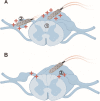Beyond treatment of chronic pain: a scoping review about epidural electrical spinal cord stimulation to restore sensorimotor and autonomic function after spinal cord injury
- PMID: 37055819
- PMCID: PMC10103526
- DOI: 10.1186/s42466-023-00241-z
Beyond treatment of chronic pain: a scoping review about epidural electrical spinal cord stimulation to restore sensorimotor and autonomic function after spinal cord injury
Abstract
Epidural electrical epinal cord stimulation (ESCS) is an established therapeutic option in various chronic pain conditions. In the last decade, proof-of-concept studies have demonstrated that ESCS in combination with task-oriented rehabilitative interventions can partially restore motor function and neurological recovery after spinal cord injury (SCI). In addition to the ESCS applications for improvement of upper and lower extremity function, ESCS has been investigated for treatment of autonomic dysfunction after SCI such as orthostatic hypotension. The aim of this overview is to present the background of ESCS, emerging concepts and its readiness to become a routine therapy in SCI beyond treatment of chronic pain conditions.
© 2023. The Author(s).
Conflict of interest statement
The authors declare that they have no competing interests.
Figures

Similar articles
-
Epidural Spinal Cord Stimulation Facilitates Immediate Restoration of Dormant Motor and Autonomic Supraspinal Pathways after Chronic Neurologically Complete Spinal Cord Injury.J Neurotrauma. 2019 Aug 1;36(15):2325-2336. doi: 10.1089/neu.2018.6006. Epub 2019 Mar 6. J Neurotrauma. 2019. PMID: 30667299 Free PMC article.
-
Epidural Spinal Cord Stimulation for Spinal Cord Injury in Humans: A Systematic Review.J Clin Med. 2024 Feb 14;13(4):1090. doi: 10.3390/jcm13041090. J Clin Med. 2024. PMID: 38398403 Free PMC article. Review.
-
Effect of epidural spinal cord stimulation after chronic spinal cord injury on volitional movement and cardiovascular function: study protocol for the phase II open label controlled E-STAND trial.BMJ Open. 2022 Jul 18;12(7):e059126. doi: 10.1136/bmjopen-2021-059126. BMJ Open. 2022. PMID: 35851008 Free PMC article.
-
The safety of epidural spinal cord stimulation to restore function after spinal cord injury: post-surgical complications and incidence of cardiovascular events.Spinal Cord. 2022 Oct;60(10):903-910. doi: 10.1038/s41393-022-00822-w. Epub 2022 Jun 14. Spinal Cord. 2022. PMID: 35701485 Clinical Trial.
-
Electrical Stimulation and Motor Function Rehabilitation in Spinal Cord Injury: A Systematic Review.Cureus. 2024 May 31;16(5):e61436. doi: 10.7759/cureus.61436. eCollection 2024 May. Cureus. 2024. PMID: 38947571 Free PMC article. Review.
Cited by
-
Miniature battery-free epidural cortical stimulators.Sci Adv. 2024 Apr 12;10(15):eadn0858. doi: 10.1126/sciadv.adn0858. Epub 2024 Apr 12. Sci Adv. 2024. PMID: 38608028 Free PMC article.
-
Spinal Cord Stimulation for Functional Restoration in Spinal Cord Injury: A Narrative Review.Cureus. 2025 Feb 6;17(2):e78610. doi: 10.7759/cureus.78610. eCollection 2025 Feb. Cureus. 2025. PMID: 40062017 Free PMC article. Review.
-
Advances in Neuromodulation and Digital Brain-Spinal Cord Interfaces for Spinal Cord Injury.Int J Mol Sci. 2025 Jun 23;26(13):6021. doi: 10.3390/ijms26136021. Int J Mol Sci. 2025. PMID: 40649800 Free PMC article. Review.
References
-
- Weidner N, Rupp R, Tansey KE. Neurological aspects of spinal cord injury. Springer; 2017.
-
- Hornby TG, Reisman DS, Ward IG, Scheets PL, Miller A, Haddad D, Fox EJ, Fritz NE, Hawkins K, Henderson CE, Hendron KL, Holleran CL, Lynskey JE, Walter A. Clinical practice guideline to improve locomotor function following chronic stroke, incomplete spinal cord injury, and brain injury. Journal of Neurologic Physical Therapy: JNPT. 2020;44(1):49–100. doi: 10.1097/NPT.0000000000000303. - DOI - PubMed
Publication types
Grants and funding
LinkOut - more resources
Full Text Sources
